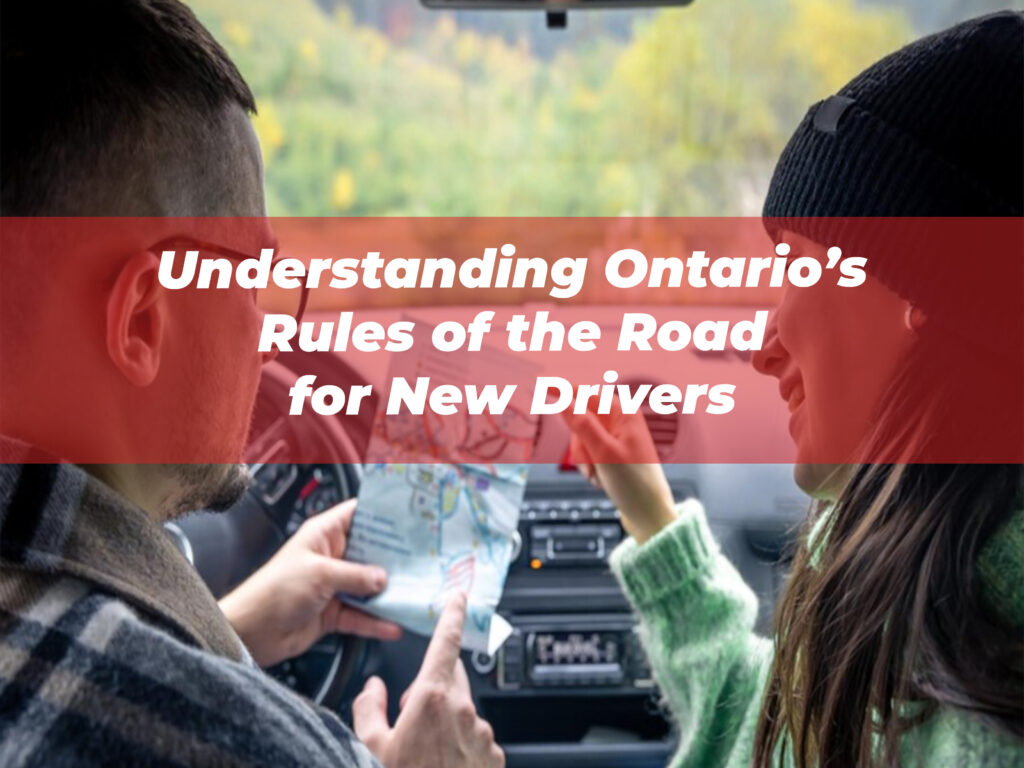Rules of the Road for New Drivers for the first time can feel both exciting and nerve-wracking. If you’re a new driver in Ontario, understanding the provincial rules of the road is essential, not only to pass your driving tests but to ensure safety for yourself and others. This guide will provide you with in-depth information about Ontario’s licensing process, key road rules, tips for new drivers, and common mistakes to avoid. By the end, you’ll feel more confident and ready to hit the road responsibly.
1. The Rules of the Road for New Drivers Process
Ontario has a step-by-step system for obtaining a Rules of the Road for New Drivers called the Graduated Licensing System (GLS). It allows new drivers to gradually gain experience and develop their skills before earning full driving privileges. Here’s how the process works:
G1 License
The G1 License is the first step in Ontario’s GLS. To apply, you must be at least 16 years old and pass both a vision test and a written knowledge test. The written test assesses your understanding of road signs, rules, and traffic laws.
Key restrictions for G1 drivers:
- Supervised driving only: You must always have a fully licensed driver with at least 4 years of G experience sitting in the front passenger seat.
- Zero blood alcohol level: New drivers are not permitted to consume alcohol before Rules of the Road for New Drivers.
- No highway driving: You cannot drive on highways with a speed limit of over 80 km/h, including the 400-series highways, unless accompanied by a driving instructor.
G2 License
After holding a G1 license for at least 12 months (or 8 months if you complete an approved driving course), you can take the G1 road test to move up to the G2 License.
With a G2 license, you can drive independently with fewer restrictions:
- You must maintain a zero blood alcohol level at all Rules of the Road for New Drivers.
- Drivers aged 19 or under face passenger limitations between midnight and 5 a.m. during the first six months of G2 driving.
Full G License
The final step is obtaining your Full G License, which you can apply for after 12 months of holding a G2. The G road test evaluates your advanced driving skills, including highway driving, merging, and lane switching. Once you pass, you’ll gain full driving Rules of the Road for New Drivers.
This graduated approach ensures new drivers build the skills and confidence needed to drive safely.
2. Key Rules of the Road in Ontario
Understanding Ontario’s rules isn’t just necessary for passing your driving tests but is crucial for your safety and that of others. Here are some key road rules every new driver should know:

Speed Limits
Speeding is one of the most common causes of collisions. Stick to posted speed Rules of the Road for New Drivers:
- 50 km/h in urban areas
- 80 km/h in rural areas
- 100 km/h on highways, unless otherwise indicated
Not following speed limits can result in hefty fines, demerit points, and increased insurance premiums.
Signaling and Right-of-Way
Always use your turn signals to inform other drivers of your intentions, whether you’re changing lanes, making turns, or pulling over.
When it comes to right-of-way:
- Pedestrians always have the right-of-way at crosswalks and intersections.
- At four-way stops, the driver to your right has the Rules of the Road for New Drivers-of-way if you arrive at the same time.
Yielding to Emergency Vehicles
If an emergency vehicle with flashing lights and sirens approaches, you’re required to pull to the side of the road and stop. Failure to do so can result in serious penalties.
Use of Seatbelts
Seatbelt use is mandatory for all passengers. As a driver, you’re responsible for ensuring every passenger under 16 is wearing one. Failing to comply can result in fines and applicable demerit points.
Distracted Driving
Ontario enforces strict distracted Rules of the Road for New Drivers laws. Using a mobile phone or any electronic device while driving (even at a red light) is illegal. Penalties include:
- Fines starting at $615
- 3-6 demerit points
- Possible license suspension
Remember, looking away from the road for even a second can lead to dangerous consequences.
Alcohol and Cannabis
For all G1 and G2 drivers, there’s absolutely no tolerance for alcohol or drugs while driving. Even a trace amount of alcohol in your system could result in license suspension, fines, and criminal charges. The same applies to cannabis use.
School Zones and School Buses
Be extra cautious in school zones, where the speed Rules of the Road for New Drivers typically drops to 30-40 km/h during school hours. When approaching a school bus with flashing red lights, stop at a safe distance and don’t proceed until the lights stop. Ignoring this could cost you a fine of up to $2,000.
3. Tips for New Drivers
Becoming a confident and responsible driver takes time and practice. Here are some practical tips to help you along the way:
1. Practice Defensive Driving
Defensive driving means staying alert, anticipating hazards, and keeping a safe distance from other vehicles. Follow the “two-second rule” to maintain enough space between you and the car ahead. On highways or in adverse Rules of the Road for New Drivers, increase this gap to four seconds.
2. Master Parallel Parking
Parallel parking can intimidate new drivers, but with regular practice, it becomes second nature. Use reference points and mirrors to align your car properly while parking. Practicing with cones or in a quiet neighborhood can help build confidence.
3. Plan Ahead
Before starting your trip, plan your route, especially if you’re driving in unfamiliar areas. Apps like Google Maps or Waze can help you avoid traffic congestion and road closures.
4. Adapt to Weather Conditions
Ontario’s winters can be harsh, and Rules of the Road for New Drivers-covered roads require careful driving. Equip your car with winter tires for better traction and reduce your speed in icy conditions.
5. Avoid Rush Hour if Possible
Driving during rush hour can be overwhelming for new drivers. If you’re not confident in heavy traffic, plan your drives during non-peak hours until you’ve gained more experience.
6. Take a Driving Course
Consider enrolling in a Ministry-approved driver education course. These programs teach essential skills and may allow you to fast-track your G1 timeline to just 8 months.
4. Common Mistakes New Drivers Should Avoid
Mistakes are part of the learning process, but understanding the most common ones can help you steer clear of unnecessary risks or fines:
1. Rolling Through Stop Signs
New drivers often underestimate the importance of fully stopping at stop signs. A “rolling stop” can lead to accidents and fines, so ensure your vehicle comes to a complete stop every time.
2. Overconfidence
It’s natural to feel more comfortable as you gain Rules of the Road for New Drivers, but overconfidence can be dangerous. Always stay attentive and cautious, especially in complex situations like merging or roundabouts.
3. Tailgating
Following too closely behind another vehicle reduces your reaction time. Keep a safe distance from the car in front to avoid rear-end collisions.
4. Failing to Shoulder Check
Checking your mirrors alone isn’t enough. Blind spots can hide other vehicles, cyclists, or pedestrians. Always do a quick shoulder check before changing lanes or turning.
5. Forgetting About Maintenance
It’s easy to forget, but regular car maintenance is key to your safety. Check your tire pressure, oil levels, and brake condition frequently. A well-maintained car is safer and more reliable.
6. Ignoring Road Signs
Every road sign in Ontario serves a purpose and is there to guide you. New drivers sometimes miss signs for speed limits, no-parking zones, or construction areas. Develop the habit of scanning for signs as you drive.
5. Road Safety Resources for New Drivers
Ontario provides plenty of resources to help new drivers stay informed and safe. Here are a few you should check out:
- Official MTO Driver’s Handbook: Everything you need to know about Ontario’s road rules and traffic signs.
- Road Test Booking Site: Book your G1 or G2 road tests online through the Ontario Rules of the Road for New Drivers website.
- Driving Schools: Look for MTO-approved driving schools that offer both in-class and Rules of the Road for New Drivers lessons.
- Road Safety Apps: Download apps like Drive Smart to practice road signs and rules.
Final Thoughts
Driving for the first time in Rules of the Road for New Drivers is an exciting milestone, but it comes with responsibility. With Ontario’s Graduated Licensing System and clear road regulations, you’ll have plenty of opportunities to become a skilled and confident driver. Always remember the importance of safety, not just for yourself but for everyone on the road.
Take your time, practice regularly, and prioritize learning from your Rules of the Road for New Drivers. Before you know it, you’ll be cruising Ontario’s roads with confidence.










